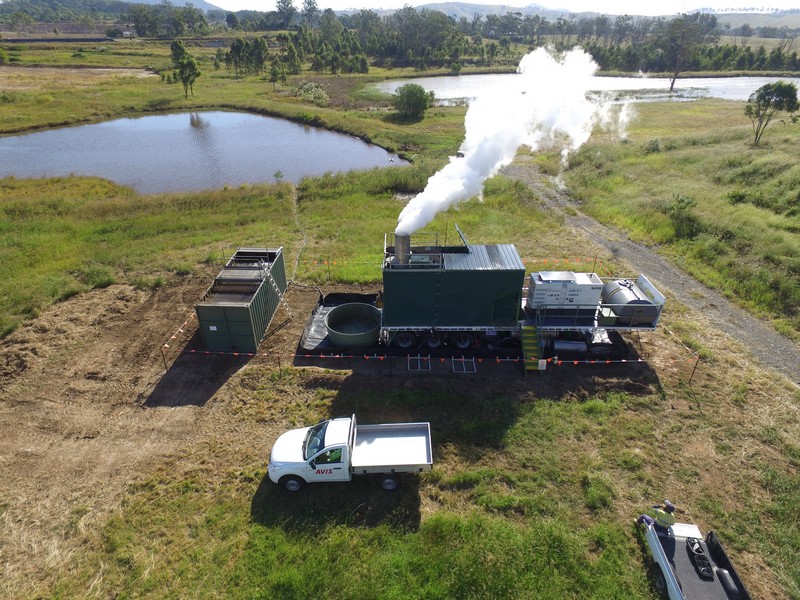Reducing wastewater in remote oil and gas projects and municipal landfill sites
Transporting wastewater from remote oil and gas projects and municipal landfill sites is a complex and costly task that carries with it health and safety risks. A new technology is minimising these risks by reducing the volume of wastewater that needs to be handled by 90 per cent, while also removing target contaminants, which is increasing project efficiency and providing significant environmental benefits.

Wastewater from remote oil and gas operations is typically transported by road, often over long distances, which drives up costs and can expose workers to the numerous risks associated with heavy vehicle transport.
Disposal of landfill leachate water can be a major problem because the leachate often requires some form of treatment to remove toxic metals, contaminants, and dissolved and suspended organic material.
A simple way to mitigate these risks lies in reducing the amount of wastewater that needs to be transported.
Tony Stapleton, Chief Operating Officer & Business Development Leader at land rehabilitation and wastewater management company BeneTerra, said it’s this problem that BeneTerra’s BeneVap unit is helping to solve.
“The BeneVap range is designed to evapoconcentrate difficult to handle wastewater coming either directly from a contamination or industrial source, or from the waste stream of another water treatment technology,” Mr Stapleton said.
“The BeneVap requires no pre or post treatment steps and can utilise a range of fuels including landfill gas, natural gas (including flared gas) or liquid fuels such as diesel or recycled oil.”
BeneTerra has been delivering practical, cost-effective environmental solutions to clients in the energy, industrial, agricultural and public sectors since 2002.
It has worked extensively in the oil and gas industry, dealing with the main byproduct of oil and gas exploration and production-produced water. The technology is used to eliminate key contaminants as well as reducing wastewater volume.
“In the process of reducing volume, the technology can also be used to remove target contaminants or to force the precipitation of various elements dissolved in the wastewater. On a recent project in 2016, we successfully reduced the wastewater volume to be transported by 99.3 per cent,” Mr Stapleton said.
The technology is now being made available to the landfill industry, where the BeneVap machine is able to remove ammonia, reduce the volume of leachate and precipitate heavy metals in a non-leachable form all in the same, singular process.
Using advanced technology to improve efficiency
Mr Stapleton said the technology is based on the principles of submerged combustion, with no vacuum or pressure vessel involved in the process and no filters or membranes to be scaled or blocked.
“It burns a fuel source (liquid or gas such as diesel or landfill gas, etc) and forces the hot combustion gas into direct contact with the liquid in the concentration vessel. This vaporises the water component of the liquid and sends pure water vapour out the exhaust stack,” Mr Stapleton said.
“Due to the amount of additional air forced into the system and the agitation this creates, together with the concentrating effects of the process, it is very effective at removing volatile organics, ammonia and hydrocarbon contamination from the resulting concentrate.

“The lack of pressure vessels or filters and membranes, and the process by which the heat is transferred from a bubble rather than a hot surface (as with other evaporators) means that there is very little maintenance, no pre-treatment steps and a relatively low regulatory compliance requirement.”
BeneVap units can connect to either a raw water source or the waste stream of another technology. They are also not confined by water chemistry and as such can treat almost any liquid.
Approximately 90-95 per cent of the potential energy from the BeneVap’s fuel source is converted into evaporation, making it extremely energy efficient.
Utilising landfill gas to remove leachate
BeneTerra is currently assisting one of Brisbane’s largest landfills to reduce the volume of leachate by over 90 per cent on a daily basis.
Mr Stapleton said that landfill leachate has a complex chemistry which includes high levels of dissolved metals, hydrocarbons, volatile organic compounds (VOCs), high levels of ammonia (at times over 2,000 ppm) and a starting salinity approaching seawater.
“The challenge that most technologies fail to handle is the constant variability in the water quality from hour to hour, day to day and from landfill cell to landfill cell. It is impossible to predict what quality you will be processing from one moment to the next,” Mr Stapleton said.
“The objective though has been to take this water, reduce its volume by 90 per cent or more and at the same time achieve air emissions well below the regulatory limits set – especially for odour.”
Mr Stapleton said that the air emissions have exceeded everyone’s expectations, including those of the Department of Environment and Heritage Protection.
“All of this was done by beneficially utilising landfill gas (which contains only 48 per cent methane approximately). A very happy client, a happy regulator and, in our opinion, a happier environment in the long term,” Mr Stapleton said.
A BV300 has been installed on the landfill site since early September 2016. The unit is monitored remotely by BeneTerra operational staff and a technician attends to the site approximately once per month to clean and perform basic maintenance.
The BV150 is the latest addition to the BeneVap range. It is even more compact and mobile than the BV300, measuring 2.8m x 2.2m and weighing in at approximately 3,000kg.
Wade Elofson, the founder of Powered, an Australian energy and resource-focused business development company, said that innovative technologies like the BeneVap unit are helping to tackle consistent industry challenges, such as wastewater, and can increase efficiency and minimise risks.
“The energy efficiency of the BeneVap technology is a key advantage and it is very simple to use, with no pretreatment steps, chemical dosing requirements or any of the safety issues associated with pressure vessels,” Mr Elofson said.
“Practical solutions such as this focus on increasing efficiency and bringing down costs, which not only benefits individuals but the industry as a whole.”


